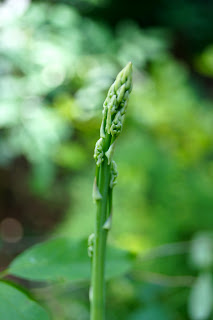Wow - has it been busy this spring with its early onset. One of the questions I am frequently asked is... what's hot in pots this spring? So, I decided it would be a great time to blog about it to share my thoughts and ask for your opinions, too.
NUMBER ONE HOTTIE THIS SPRING...would have to be succulent plants.
Look at this amazing container of succulents... I think the hypertufa "toad house" and "blue fingers" succulent corner "tree" planting just give this container a "wow" factor. Posted this photo on Charlie Thigpen's Garden Gallery page and within the day a gentleman came in and purchased the entire container for his wife's birthday present!
So, what are some succulents you should try?
Here is Mezoo Trailing Red in front and like its name implies is more of a trailing succulent which will spill out of the pot and Campfire succulent is in back and is more upright with flaming red tips!
And why should you try a succulent?
Because in addition to being drought tolerant, they thrive with neglect and are perfect for containers, which dry out more quickly in our scorching heat. Most have the added bonus of blooms during summer. Perennial, they are constant year after year for you in your container.
On the front left is 'John Creech' Stonecrop which has pink flowers blooming in July/August, 'Hen and Chicks' Sempervivam hybrid on the right and Echeveria nodulosa in back which has striking gray/maroon foliage and is more upright to 8 inches.
I made my own container of succulents in an unused copper fire pit with drainage, and bought a toad house for our frog!
NUMBER TWO CONTAINER HOTTIE...would have to be herbs.
Look at this ornamental oregano, Kent Beauty.
Pink and lime green flower bracts bloom in spring and summer. The leaves are heart shaped and like the succulents, water sparingly as too much water will cause root rot. Again, photo posted on the Facebook page and within the day container and all SOLD!
Another great herb to try is 'Sweet Thai' Basil. Not only does it taste great, it is highly ornamental.
'Lemon' Basil and 'Golden Lemon' Thyme are two others you should try!
NUMBER THREE HOTS FOR POTS... would have to be blooming, tough plants.
My front containers get at least a half day of sunlight and by July or August, it is HOT and DRY. Tired of watering constantly, this year I have used these combination of plants:
'Hot Lips' Salvia - I mean, what can be hotter than this? The "thriller" for my pot.
'Butterfly Red' Pentas which are loved by butterflies and hummingbirds.
'AngelMist' Spreading White Angelonia
Portulaca 'Sundial White'
Mezoo Trailing Red succulent - Dorotheanthus Red
Here it is all together planted just yesterday:
When it fills in and matures, I will be sure to update you with a photo.
HOW MUCH WILL IT COST PER CONTAINER?
Plants can range anywhere from $2.95 for a 6 cell pack, to $2.95-4.95 for a 4 inch pot. Expect to pay somewhere in the $4.95-9.95 range for 6 inch to 1 gallon pots. Perennials generally cost more that annuals.
I spent $8.95 for the1 gallon Pentas, $4.95 for the 6 inch 'Hot Lips' Salvia, $4.95 for the 6 inch AngelMist Angelonia, $2.95 for the 6 cell pack of Portulaca (used 3 per container) and $4.95 for the Mezoo Trailing Red succulent. So, roughly $25.50 per container that will last throughout summer and most of fall!
PLEASE let me KNOW some of your spring/summer HOT plants to try. I would love to hear from you!
PHOTOS COURTESY OF:
Hilary Ross
MATER NATURA DESIGNS




























































